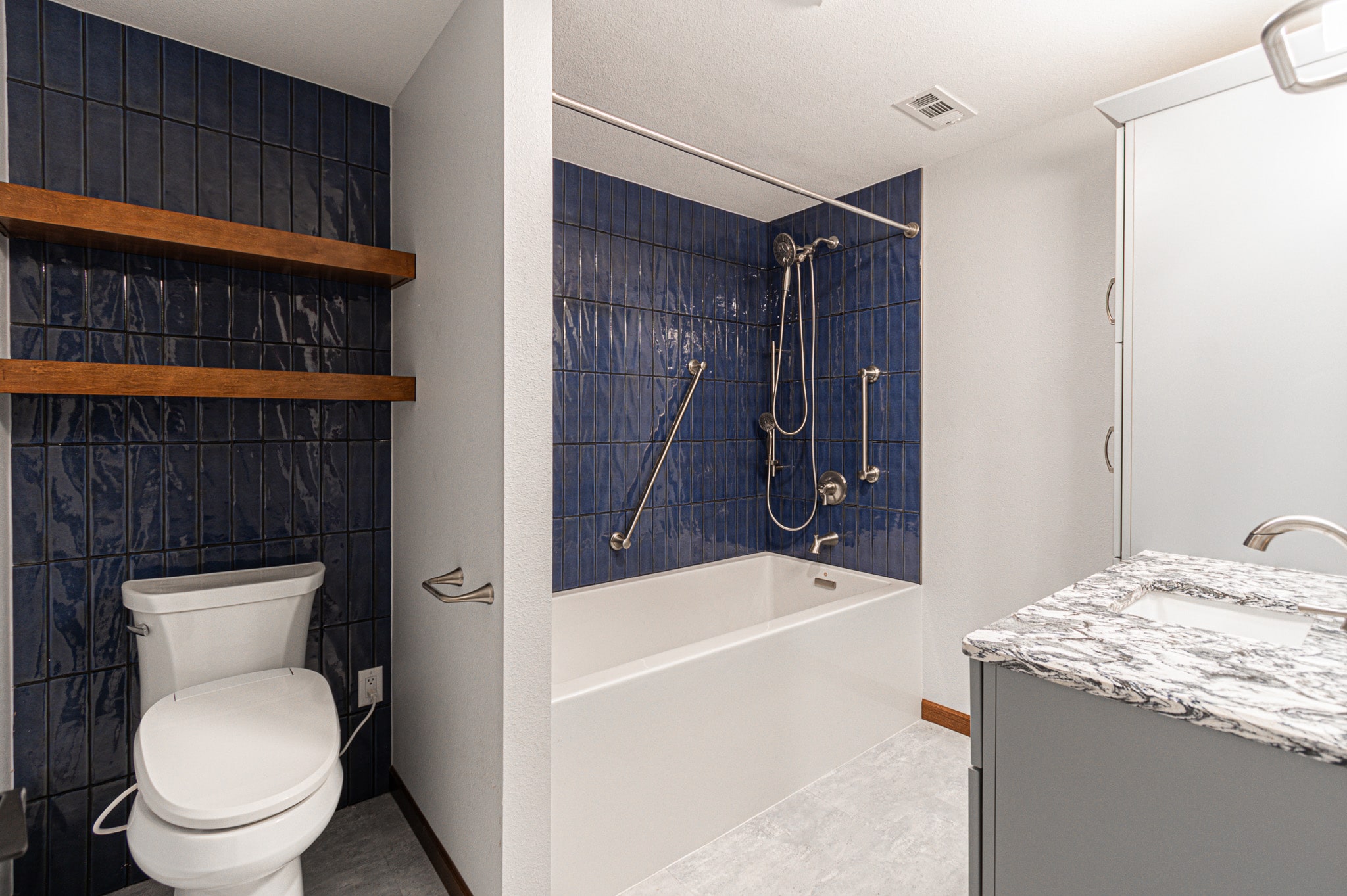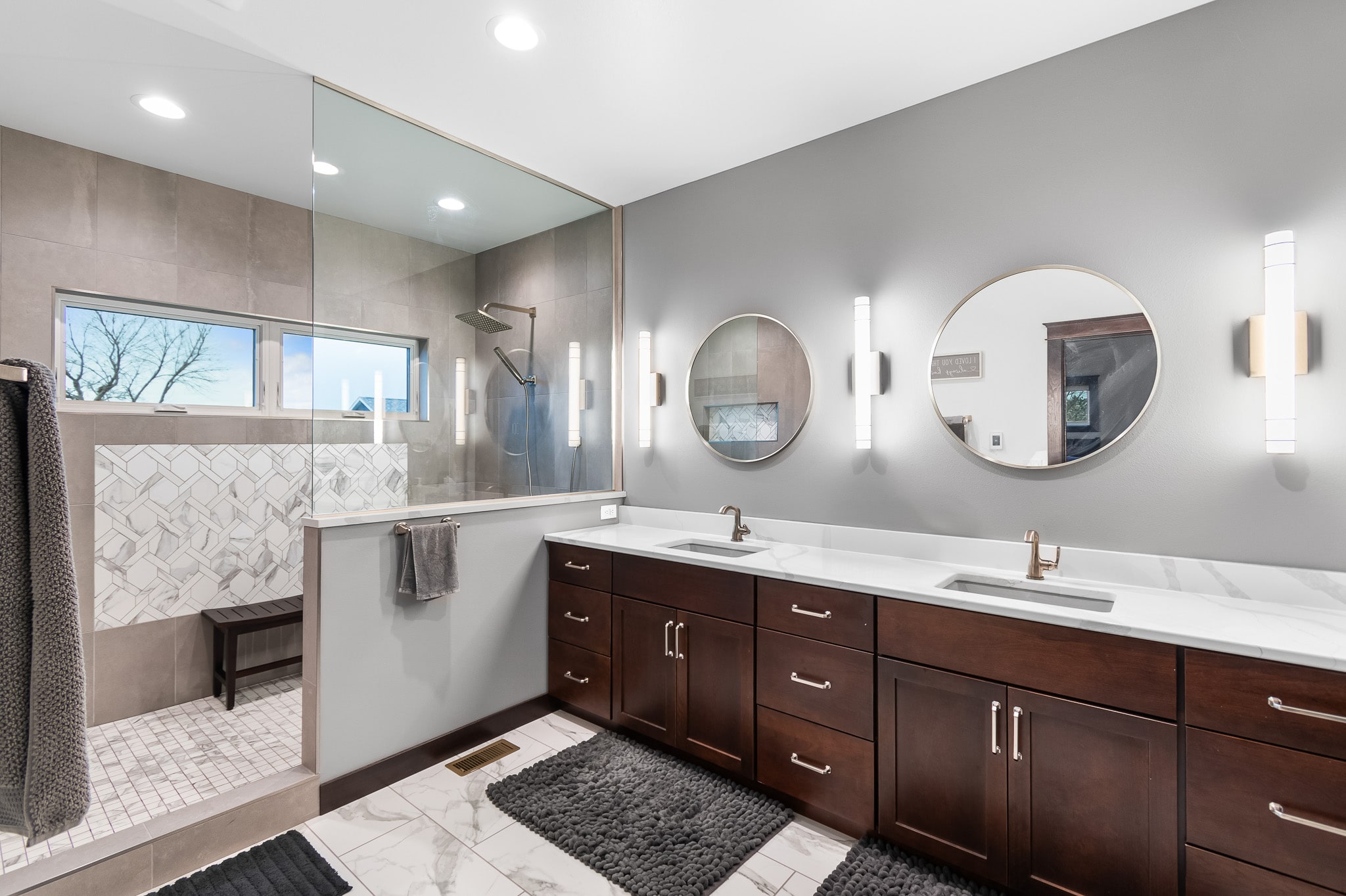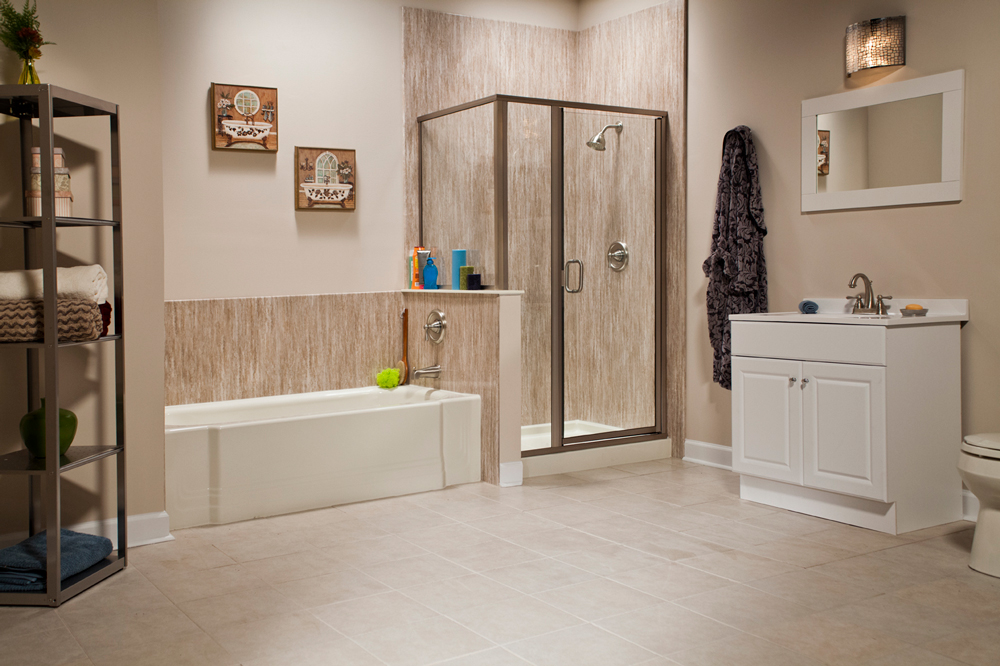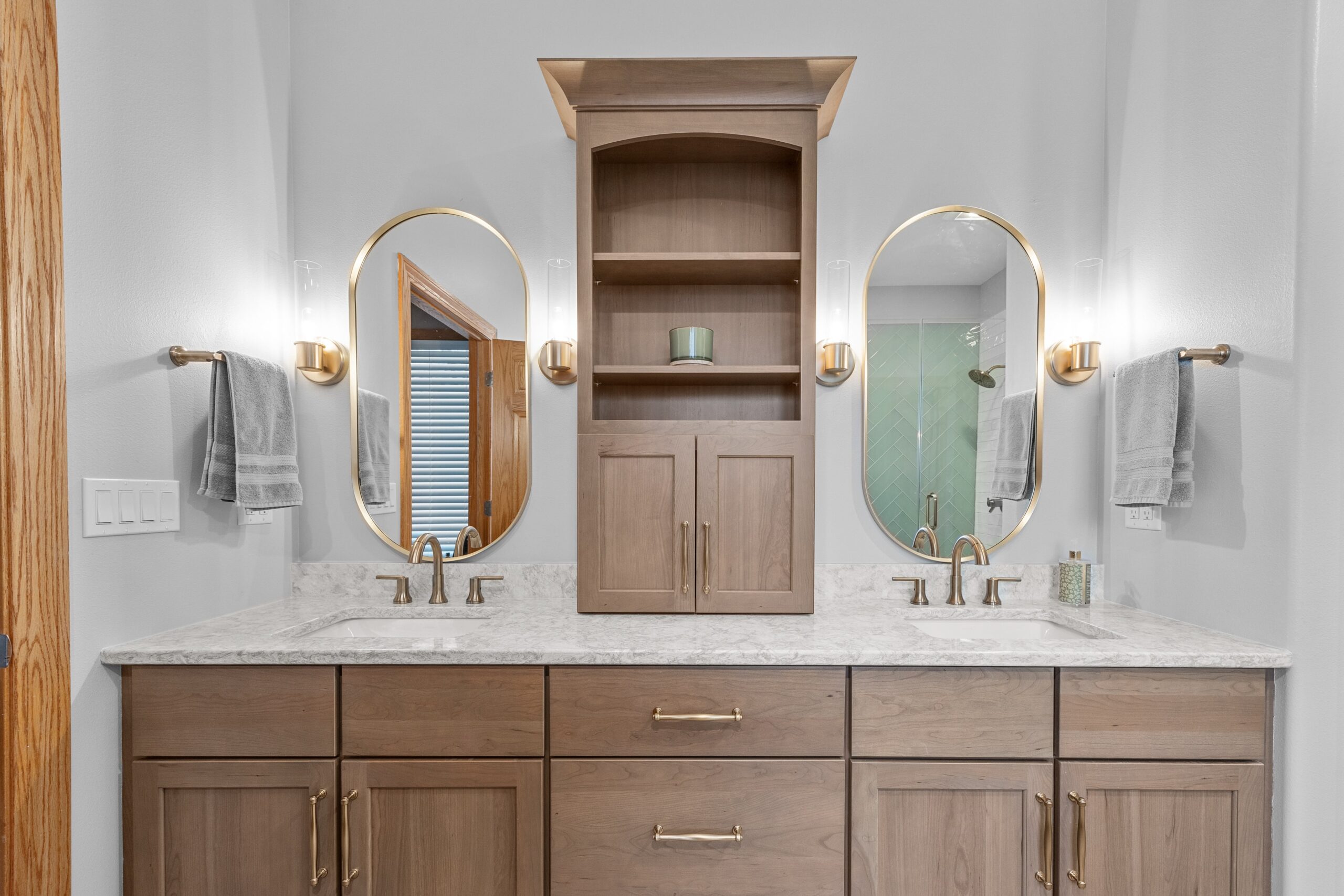If you’re thinking about updating your bathroom, one of the first questions you’re asking after “how much will it cost?” is: “How long does it take to remodel a bathroom?” The truth is, timelines vary depending on the scope of work. Whether you’re gutting the space or just making a few upgrades, having realistic expectations about your timeline will help you plan for your project effectively.
Custom Bath | Basic Bath | Primary Bath | Timeline | DIY Bathroom
In this Straight Talk article, we break down the bathroom remodel timeline for different project types, answer common questions like “Can a bathroom remodel be done in a day?”, and offer no-nonsense tips to help you start your remodel the right way.
How long does a custom full bathroom remodel take?
A custom full bathroom remodel (meaning everything from demolition to new plumbing, electrical, flooring, and fixtures) typically takes 3 to 6 weeks of active construction, not including the time spent on planning, design, and ordering materials.
Bathroom Remodel Timeline (Full Remodel):
- Design & Planning: 1–3 weeks
- Permits & Product Ordering: 3-10 weeks
- Demolition: 1-3 days
- Rough-ins (Plumbing & Electrical): 2–5 days
- Inspections: 1 day
- Tile, Flooring & Drywall: 1–2 weeks
- Fixtures & Finishes Install: 1-2 days
- Final Touches & Cleanup: 2–3 days
Can a bathroom remodel be done in a day?
You’ve probably seen ads from companies promising a “new bathroom in just one day.” Here’s what they’re usually offering: a tub or shower replacement. Typically, they’re offering a fiberglass insert placed over your existing tub or walls. That can be a good solution in some situations, especially if you’re dealing with outdated but functional plumbing and simply want a quick and clean solution. However, anything more complex, such as moving a toilet, replacing vanities, adding lighting, or custom tile work, can’t realistically be done in one day.
What to watch for when someone promises a bathroom-in-a-day:
- Speed vs. quality: One-day installations often involve materials and tactics that don’t last as long or look as sharp as high-quality solutions.
- Hidden damage: If there’s water damage behind your walls, a one-day installer may not take the time to fix it.
- Cost vs. value: It may be cheaper upfront, but not always. And if it needs replacing sooner, it may cost you more in the long run.
How will the bathroom materials I choose affect my timeline?
Your timeline can shrink or stretch depending on what materials you choose. A prefab shower insert can be installed in a day or two, but custom tile can take over a week, especially if you’re including niches, accent borders, or complex patterns. Stock vanities may be ready for install as soon as demo wraps up, but a custom unit could have a 6–8 week lead time.
Bath Planet Bathroom Remodels
At Hometown Restyling, we offer both fully custom bathrooms and Bath Planet remodels. We partner with Bath Planet because their acrylic systems are custom-fit, easy to maintain, and built to last. Most projects focus on the wet space and take just 2 days to complete, or up to 2 weeks for a full bathroom refresh. The design process is quick, too: typically just 1 or 2 meetings. And our team helps you choose what fits your needs and timeline.
StraightTALK Remodeling Tip:
Add one week of buffer time into your remodel plan — even if everything looks smooth on paper. We’ve seen perfectly scheduled projects get delayed by something as simple as a missing plumbing fitting or a cracked tile shipment. For example, if you’re ordering a custom vanity and it arrives damaged, your entire project might be delayed a week while a replacement is sourced. Planning for the unexpected helps keep your stress level in check and your project moving forward.
How long does a basic bathroom remodel take?
A basic bathroom remodel (which we’re defining as: no layout changes and no plumbing or electrical moves) can be completed much faster. These are often surface updates, such as new paint, flooring, vanity, lighting, and hardware. And if you’ve already chosen designs and have products available, it can be completed in a week.
Typical Timeline: 1–2 Weeks
- Demo (if any): 1–2 days
- Install Fixtures, Flooring, Paint: 3–5 days
- Finishing Touches: 1–2 days
StraightTALK Remodeling Tip:
Just because it’s a “basic” remodel doesn’t mean it’s risk-free. We’ve had clients buy vanities that didn’t align with their existing plumbing or lights that required junction box updates. Before you order anything, check the specs against what’s already in your bathroom. For example, a new light fixture might require a deeper electrical box, which could change the installation time if drywall work is also required.
At Hometown Restyling, we place a great deal of trust in our designers to work closely with you from the very early stages of our process, planning the details of your bathroom remodel project. This enables us to plan for deliveries and labor as needed.
How long does it take to remodel a primary bathroom?
Remodeling a primary bathroom (often referred to as a master bath) involves more than just extra square footage. These spaces typically feature custom finishes, amenities specific to your style, and dual-purpose functionality, such as double vanities, walk-in showers, freestanding tubs, and private toilet areas. All of that adds comfort as well as complexity, which translates into a longer timeline.
Timeline: 10–20+ Weeks
- Design & Custom Selections: 2–4 weeks
- Permits & Product Ordering: 4-10 weeks
- Demolition & Rough-ins: 1 week
- Tile, Glass, & Finishes: 2–3 weeks
- Cabinets, Countertops, & Final Install: 1–2 weeks
What choices extend the timeline of a primary bath remodel?
Choosing a custom tile shower instead of a prefab surround adds both complexity and time. Tile installation involves multiple steps, including waterproofing, setting, grouting, and curing, which can take several days or more. In contrast, a prefabricated fiberglass or acrylic shower can often be installed in a day or two.
If you’re removing a tub and converting the space into a walk-in shower, expect additional framing, plumbing adjustments, and possibly structural changes to meet code or support a larger footprint. This type of change typically adds several days to your timeline and requires careful coordination across trades.
Adding a water closet or building a privacy wall involves framing, drywall, and sometimes rerouting plumbing or electrical lines. Although it may seem like a minor addition, this type of layout change typically requires permits and inspections, all of which can add time to the project.
Custom vanities, especially those with double sinks, almost always require changes to your existing plumbing. You may need to relocate drain lines, adjust supply locations, or modify cabinetry to accommodate around structural elements. These updates are par for the course at Hometown Restyling and are always worth it to achieve your dream primary bathroom, but they require time and coordination between trades.
StraightTALK Remodeling Tip:
For a smooth master bath remodel, ensure that all your selections are made and ordered before demolition begins. We’ve seen projects stall for weeks waiting on a backordered shower door or a specialty tile that was forgotten. For example, if you’re going with a frameless glass enclosure, those usually can’t be measured until the tile is complete, and fabrication takes time. If your schedule depends on one piece arriving late, everything else can grind to a halt.
Bathroom Remodel Timelines Compared: Hall vs. Primary Bath
| Type of Remodel | Planning, Design, Ordering | Active Construction | Total Time (Estimate) |
| Basic Hall Bath | 2-4 weeks | 1–2 weeks | 3–6 weeks |
| Primary Bath | 6–14 weeks | 4–6 weeks | 10–20 weeks |
A simple powder room can often be completed more quickly due to its fewer fixtures and smaller square footage. Powder rooms or half baths typically require less demo and fewer materials, but they come with their own unique challenges. Small spaces can be tricky to work in and may require custom-sized vanities or corner sinks to fit properly. Limited layout options can also make every inch of planning more critical.
Can you keep part of the bathroom functional during a remodel?
In most cases, you cannot keep part of the bathroom functional for much of the remodel, at least not easily. Once the demo begins, items such as the toilet, shower, and vanity are often disconnected or removed entirely. While you can preserve the toilet or sink for a few days during a phased project, it’s rarely practical or efficient. For one-bathroom households, make a solid temporary plan.
StraightTALK Remodeling Tip:
If your only full bathroom is under construction, have a backup plan for showering. We’ve seen it all: clients using their neighbor’s bathroom, renting an RV, staying in hotels, even joining a gym just for shower access. Don’t wait until your shower is disconnected to think about where you’re going to clean up.
What is the timeline for a bathroom remodel?
The timeline for your bathroom remodel will vary depending on the size of the bathroom, scope of work, and materials you choose. Here’s a general step-by-step bathroom remodel schedule to help you visualize the process:
| Phase | What Happens | Time Estimate |
| Design & Planning | Layout, selections, quotes | 1–3+ weeks |
| Product Ordering | Fixtures, tile, cabinetry, specialty items | 1–4+ weeks |
| Demolition | Tearing out existing materials | 1–5 days |
| Rough-ins | Plumbing, electrical, framing | 3–7 days |
| Inspections | Municipal approval of work | 1–3 days |
| Tile & Flooring Installation | Includes drying/curing time | 5–10 days |
| Fixture & Cabinet Installation | Sink, vanity, toilet, shower, lighting | 3–5 days |
| Final Touches | Paint, trim, mirror, hardware | 1–2 days |
| Punch List | Final walk-through, adjustments | 1–3 days |
What can slow down a bathroom remodel?
Even the best-planned bathroom remodels can run into surprises that slow down the remodel timeline. One of the most common is uncovering hidden water damage or mold behind walls or under old flooring. These issues must be addressed before moving forward, often requiring extra demolition, drying time, or even bringing in specialists, which can set your timeline back by days or even weeks.
Delays also occur when special-order materials arrive late or are damaged. That beautiful custom vanity or specialty tile you chose? If it’s backordered or arrives cracked, the entire project might pause until a replacement arrives. This is why ordering early and inspecting deliveries as soon as they arrive is key. And why we design and plan well ahead of the scheduled demolition date.
Failed inspections are another timeline killer. If plumbing, electrical, or framing work doesn’t meet local code, you’ll need to schedule re-inspections after corrections are made. Each round of approval takes time, and in some cities, getting an inspector back on site can take several days. Make sure that permitting and inspections aren’t what slow down your bathroom remodel by hiring a reputable contractor that is local and therefore knows the processes in your area.
Subcontractor scheduling gaps can also slow down the process. If one trade finishes early but the next isn’t available until later in the week, your project sits idle. This is why detailed scheduling and trade coordination are so crucial, and why experienced contractors often build padding into their timelines and only work with subcontractors they trust.
Finally, scope creep and change orders (adding new work mid-project) are a major cause of delays. It’s tempting to say “while you’re in there, can we also…” but even small changes can have big ripple effects. Adding a recessed niche or switching out fixtures midstream requires adjusting materials, timelines, and possibly obtaining new permits.
StraightTALK Remodeling Tip:
Staying organized is everything. We recommend using a simple calendar or spreadsheet to track each phase of the project. For example, if your tile guy is coming on Monday, you want to be sure your rough plumbing inspection passes by Friday. A little planning here avoids major downtime — and keeps trades from stepping on each other’s toes.

Is it hard to remodel a bathroom yourself?
The amount of difficulty in remodeling your bathroom yourself depends on the scope of your bathroom remodeling goals and your skill level. DIY can be rewarding and save money if you have the right skillset, but it also comes with real risks and longer timelines. How long it takes depends on your experience, availability, and the complexity of the remodel.
DIY time estimates are often 2-3x longer than hiring an expert craftsman
- Cosmetic Refresh (paint, fixtures): 1–2 weekends
- Basic Remodel: 3–5 weekends
- Full Remodel: 6–12 weekends (or more, depending on skill)
Should you DIY your bathroom remodel?
DIY might save you a few dollars up front, but only if you know your limits. Before you commit, ask yourself a few key questions:
- Do you have experience with plumbing, electrical work, and tiling?
- Can you dedicate uninterrupted time to the project?
- Do you have a second bathroom to use?
- Are you okay living with a demoed space for weeks (or months)?
We are often called in after someone has started a DIY remodel and become stuck. It usually begins with a demo that progresses quickly, but then plumbing or electrical changes are more challenging than expected. We’ve walked into homes where the toilet was removed weeks ago, the shower’s torn apart, and the homeowner’s been using the basement sink to wash up. The project was well-intentioned from the beginning, but life often gets in the way and eventually you need a functional bathroom.
Cosmetic tasks, such as painting, hardware swaps, and even flooring, can be DIY-friendly. But the moment you’re dealing with wet walls, electrical code, or waterproofing, mistakes get expensive. For example, improperly sealed tile can lead to leaks that damage floors or joists, and then you’re back to square one, only worse.
Do you need permits for a bathroom remodel?
In most cities, bathroom remodels typically require a permit. Even a minor bathroom update may require permits if you’re touching plumbing or electrical work. As a DIYer, that means pulling your own permits and scheduling inspections. This can delay your timeline further if you’re not familiar with your city’s process. And if your work doesn’t pass? You’re responsible for fixing it before moving on.
For example, in Cedar Rapids, moving plumbing or electrical work during a bathroom remodel typically requires separate, trade-specific permits. The city’s Building & Trades department issues distinct permits for plumbing, electrical, and mechanical work that alters supply lines, drainage, wiring, or fixtures. Homeowners can pull permits if they claim the homestead exemption for a single‑family dwelling; otherwise, a licensed contractor must handle the permit and work.
To get a permit in Cedar Rapids, you’ll submit an application (often through the Customer Self Service (CSS) portal), including details about what plumbing or electrical systems are changing, who is doing the work, and plans or diagrams showing the scope.
After submission, inspections are required at each phase: rough‑in plumbing/electrical before drywall or wall closure, and final inspections after everything is installed.
This process adds to the bathroom remodel timeline, so it’s smart to account for time to prepare detailed drawings, wait for permit review, and schedule required inspections in Cedar Rapids.
Tool List for a DIY Bathroom Remodel:
If you’re taking the DIY route, the right tools make all the difference. Beyond the basics like paintbrushes and screwdrivers, you’ll need tools specifically designed for bathroom renovation work, especially if you’re tackling tasks such as tile installation, plumbing, or demolition.
- Safety gear (gloves, goggles, masks)
- Utility knife, pry bar, hammer for demo
- Cordless drill, bits, screwdrivers
- Tile cutter or wet saw
- Level, measuring tape, chalk line
- Paint supplies (roller, brushes, tape)
- Wrenches, pipe cutter, Teflon tape for plumbing
- Multimeter (for electrical safety)
- Buckets, sponges, and rags for cleanup
StraightTALK Remodeling Tip:
If you’re going the DIY route, start small and don’t hesitate to hire professionals for more complex tasks. Perhaps you handle the demo and painting, but bring in a licensed plumber for the rough-in work. The goal is to have your dream bathroom up and running. And remember: time is money, too. If you’re dragging your project out over six months of weekends, that’s a long time to live with a non-functioning bathroom.
Whether you’re planning a complete gut renovation or a simple refresh, knowing your bathroom remodel timeline helps set realistic expectations. From the planning stage to the final walkthrough, timelines depend on the size of the space, the complexity of the work, and your level of preparedness when the work begins.
Here’s the big picture: You may want your bathroom done ASAP, but a quality contractor often has a 2–3 month waitlist. That can feel like a long time until you compare it to doing the work yourself. If you start now and do it on your own weekends, you might not have a working bathroom for 6 months. If you wait a couple of months, hire an expert craftsman, and get it done in 3–5 weeks? That’s a pretty smart trade.
Want to know what kind of budget goes along with those timelines? Check out our full guide to how much a bathroom remodel costs.



